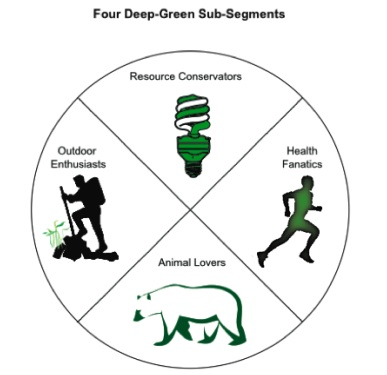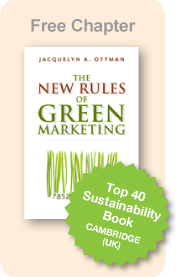Jacquie Ottman's
Green Marketing Blog
A Smart New Way to Segment Green Consumers
February 06, 2010 by Jacquelyn Ottman
When you target customers, it helps to know if they’re “dark green”, “light green” or “basic brown” in their attitudes, but, with so many green issues, products, and labels out there, it may be more relevant to your branding and communications to understand their personal green interests.
Ask: To which environmental organizations do members of our target audience belong (The Appalachian Mountain Club or Greenpeace)? Which types of vacations do they take (hiking or the beach)? Which environmental magazines and websites do they read or visit? (Sierra or Animal Fair?) Which types of products do they buy? (green fashions or energy-sipping light bulbs)? Which eco-labels do they seek out (“USDA Organic” or “Energy Star”)?
In observing green consumers over the past twenty years my colleagues and I have found that asking questions like these allows companies to distinguish between four subsegments, which we’ve dubbed “Resource Conservers”, “Health Fanatics”, “Animal Lovers” and “Outdoor Enthusiasts.” Of course, there are some overlaps among these groups, but discovering which subsegment your customers mainly fall into can sharpen your marketing. The following descriptions are generalizations, but they capture the spirit of each type of consumer.
Resource Conservers hate waste. (I should know. I am one.) Spot them wearing classically styled clothing, toting cloth shopping bags and sipping from reusable water bottles. Avid recyclers of milk jugs and Tide bottles, they drop off old electronics at Best Buy. They read news on-line to save trees, and are quick to re-use their Reynolds wrap. Ever watchful of saving their “drops” and “watts,” they install low-flow showerheads and compact fluorescent bulbs branded with EPA’s Energy Star and WaterSense labels. Shunning over-packaged products, they only turn on the lights when they have to, and they plug their appliances into power strips for easy shut-off when they leave for work.
Some ways to appeal to resource conservers:
1. Highlight the economical, long-lasting and reusability benefits of products.
2. Offer services that enable them to recycle, compost and save energy.
Health Fanatics worry about overexposure to the sun, fear pesticide residues on produce, and fret over contaminants in children’s toys. They apply sunscreen, scout out natural-food stores for the latest in organic foods, buy only natural cosmetics and pet care, and have switched out the toxic cleaning products for the non-toxic ones under the sink. They look for products marked with the “USDA Organic” seal of approval or EPA’s Design for Environment logo.They scrutinize websites like Michigan-based Ecology Center’s HealthyStuff.org and HealthyToys.org to get the skinny on toxic substances on products from school supplies to automobiles. Find them on the memberships rolls of Beyond Pesticides, Organic Consumers Association and to be regular readers of Natural Life Magazine.
Some ways to appeal to health fanatics:
1. Focus on organic aspects, health benefits, trust, transparency and natural ingredients.
2. Cross-promote with organic foods companies or a non-toxic cleaning product or sponsor a website like OrganicConsumers.org, or advertise in Natural Life Magazine.

Animal Lovers are likely to be vegetarian or vegan, belong to People for the Ethical Treatment of Animals (PETA), and boycott tuna and products with real fur. They look for products labeled as “cruelty-free”, Salmon Safe, or Dolphin-safe. They seek out synthetic handbags and faux fur jackets, and favor the faux-meat options at restaurants. They perk up to news stories featuring animals in need, from manatees and polar bears to strays in their neighborhood, and are likely to volunteer at the local animal shelter. Out of concern for marine life, they eschew plastic bags. Catch them reading Animal Fair Magazine and Veg News Magazine.
Some ways to appeal to animal lovers:
1. Conduct a cause-related marketing campaign through PETA’s Business Friends program or partner with the ASPCA.
2. Advertise in Animal Fair Magazine and PAWS magazine or online on WWF.org.
Outdoor Enthusiasts spend their free time camping, rock climbing, skiing, and hiking. They vacation in national parks and plan their next adventure using tips from Outdoors Magazine. Whether they’re purchasing Dr. Bronner’s Castile Soap to reduce the impact of washing dishes while camping, or toting reusable bottles like Kleen Kanteen to avoid littering the trail, they seek to minimize the impact of their recreational activities. When shopping, they look for FSC (sustainably harvested) labels on their products, are also likely to purchase outdoor gear made from recycled materials, such as Synchilla PCR (post-consumer recycled polyester) from Patagonia.
Some ways to appeal to outdoor enthusiasts:
1. Conduct a joint promotion with national parks or manufacturers of boots, reusable bottles, and trail mix snacks.
2. Advertise in Sierra Club magazine or online at Backpackers.com.
How do you segment your green customers? And how does that affect your marketing strategy?
Jacquelyn Ottman is president of J. Ottman Consulting, Inc., a New York-based marketing consulting firm that specializes in helping consumer businesses derive competitive advantage from eco-innovation and green marketing.
This blog was originally published by Harvard Business Press.org. It was excerpted from her latest book on green marketing, due out in 2010. Learn more about it by linking here.
Contact Us to learn more about J. Ottman’s green marketing services.
Follow Jacquie on Twitter
Read Jacquie Ottman’s Green Marketing Blog



 ShareThis
ShareThis

